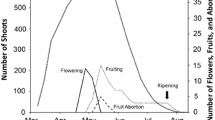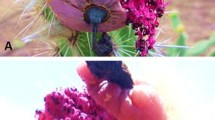Summary
Fruit removal rates ofMyoporum acuminatum in a Queensland population were correlated with size of the ripe fruit crop throughout the season, but only sporadically correlated with nutritive contents of the fruits. Removal rates, as a proportion of crop size, varied synchronously among individuals and did not differ consistently among individuals with differing fruit traits. The principal avian consumer wasMeliphaga lewinii.
Similar content being viewed by others
References
Best, L. S. (1981) The effect of specific fruit and plant characteristics in seed dispersal. Ph.D. Thesis, University of Washington.
Bronstein, J. L. and Hoffman, K. (1987). Spatial and temporal variation in frugivory at a neotropical fig.Ficus pertusa. Oikos 49, 261–8.
Davidar, P. and Morton, E. S. (1986). The relationship between fruit crop sizes and fruit removal rates by birds.Ecology 67, 262–5.
Debussche, M., Cortez, J., and Rimbault, I. (1987). Variation in fleshy fruit composition in the Mediterranean region: The importance of ripening season, life-form, fruit type and geographical distribution.Oikos 49, 244–52.
Denslow, J. S. (1987). Fruit removal rates from aggregated and isolated bushes of the red elderberry,Sambucus pubens.Can. J. Bot. 65, 1229–35.
Denslow, J. S. and Moermond, T. C. (1982). The effect of accessibility on rates of fruit removal from tropical shrubs: An experimental study.Oecologia 54, 170–6.
Denslow, J. S., Moermond, T. C. and Levey, D. J. (1986). Spatial components of fruit display in understory trees and shrubs. InFrugivores and seed dispersal (A. Estrada and T. Fleming, eds.) pp. 37–44. Junk, Dordrecht.
Forde, N. (1986). Relationships between birds and fruits in temperate Australia. InThe Dynamic Partnership: Birds and plants in southern Australia (H. A. Ford and D. C. Paton, eds.) pp. 42–58 Woolman (Govt Printer), S.A.
Goldman, D. A. and Willson, M. F. (1986). Sex allocation in functionally hermaphroditic plants: A review and critique.Bot. Rev.,521, 158–94.
Herrera, C. M. (1984). Seed dispersal and fitness determinants in wild rose: Combined effects of hawthorn, birds, mice and browsing ungulates.Oecologia 63, 386–93.
Herrera, C. M. (1985). Determinants of plant-animal coevolution: The case of mutualistic dispersal of seeds by vertebrates.Oikos 44, 132–41.
Howe, H. F. and Smallwood, J. (1982). Ecology of seed dispersal.Ann. Rev. Ecol. Syst. 13, 201–28.
Howe, H. F. and van de Kerckhove, G. A. (1980). Nutmeg dispersal by tropical birds.Science 210, 925–7.
Howe, H. F. and van de Kerckhove, G. A. (1981) Removal of wild nutmeg (Virola surinamensis) crops by birds.Ecology 62, 1093–1106.
Janson, C. H., stiles, E. W. and White, D. W. (1986) Selection on plant fruiting traits by brown capuchin monkeys: a multi-variate approach. InFrugivores and seed dispersal (A. Estrada and T. Fleming, eds.) pp. 83–92. Junk, Dordrecht.
Jordano, P. (1982). Migrant birds are the main seed dispersers of blackberries in southern Spain.Oikos 38, 183–93.
Jordano, P. (1984). Seed weight variation and differential avian dispersal in blackberriesRubus ulmifolius.Oikos 43, 149–53.
Lea, A. M. and Gray, J. T. (1935). The food of Australian birds.Emu 34, 275–92.
Levey, D. J. (1987). Sugar-tasting ability and fruit selection in tropical fruit-eating birds.Auk 104, 173–79.
Levey, D. J., Moermond, T. C. and Denslow, J. S. (1984). Fruit choice in neotropical birds: The effect of distance between fruits on preference patterns.Ecology 65, 844–50.
Moermond, T. C. and Denslow, J. S. (1983). Fruit choice in neotropical birds: Effects of fruit types and accessibility on selectivity.J. Anim. Ecol. 52, 407–20.
Moore, L. A. and Willson, M. F. (1982). The effect of microhabitat, spatial distribution, and display size on dispersal ofLindera benzoin by avian frugivores.Can. J. Bot. 60, 557–60.
Murray, K. G. (1987). Selection for optimal fruit-crop size in bird-dispersed plants.Amer. Natur. 129, 18–31.
Piper, J. K. (1986a) Effects of habitat and size of fruit display on removal ofSmilacina stellata (Liliaceae) fruits.Can. J. Bot. 64, 1050–4.
Piper, J. K. (1986b) Seasonality of fruit characters and seed removal by birds.Oikos 46, 303–10.
Primack, R. B. (1985) Comparative studies of fruits in wild and cultivated trees of chempedak (Artocarpus integer) and terap (Artocarpus odoratissimus) in Sarawak, East Malaysia, with additional information on the reproductive biology of the Moraceae in Southeast Asia.Malaya Nature J. 39, 1–39.
Sakai, A. K. and Burris, T. A. (1985). Growth in male and female aspen clones: A twenty-five year longitudinal study.Ecology 66, 1921–7.
Sorensen, A. E. (1983). Taste aversion and frugivore preference.Oecologia 56, 117–20.
Sorensen, A. E. (1984). Nutrition energy and passage time: Experiments with fruit preferences in European blackbirds (Turdus merula).J. Anim. Ecol. 53, 545–57.
Willson, M. F. (1983)Plant Reproductive Ecology, Wiley-Interscience, New York.
Willson, M. F., Irvine, A. K. and Walsh, N. G. Vertebrate dispersal syndromes in Australian and New Zealand plant communities with some geographic comparisons.Biotropica. In press.
Author information
Authors and Affiliations
Rights and permissions
About this article
Cite this article
Willson, M.F. Phenology of vertebrate removal ofMyoporum accuminatum fruits in a Queensland forest. Evol Ecol 2, 283–288 (1988). https://doi.org/10.1007/BF02207561
Issue Date:
DOI: https://doi.org/10.1007/BF02207561




